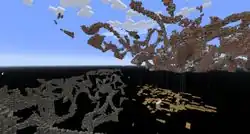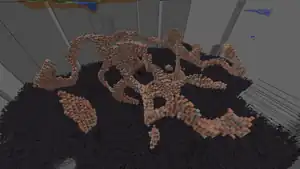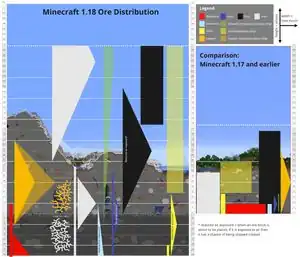Ore vein

| Biomes |
Any |
|---|---|
| Consists of |
|
{
"title": "Ore vein",
"rows": [
{
"field": "Any",
"label": "(link to Biome article, displayed as Biomes)"
},
{
"field": "(values exceeds 1000 characters...)",
"label": "Consists of"
}
],
"invimages": [],
"images": [
"Ore veins.jpg"
]
}
An ore vein is a rare underground terrain feature that provides massive amounts of ore.
Structure

Ore veins occur as large branching networks of a filler rock, paired with high concentrations of an associated ore type. Copper veins generate above Y=0 and contain copper ore and raw copper, with granite as the filler material. Iron veins generate below Y=0 and contain iron ore and raw iron, with tuff as the filler material.
Ore veins can snake and branch and eventually dead-end, and are similar to spaghetti caves in their shape and scale. Where they intersect caves, the player can easily spot them in the floors, walls, and ceilings. In some cases, more than 2,000 of a particular ore can be found in a single vein. Like most generated features, including structures, they seem to tend to go sideways; and: roughly, the smallest seem to be a few dozen blocks long, and the larger, a few hundred .
Technically, ore veins are a part of cave generation and are not decorators. This means they are overridden by caves, mineshafts or other underground structures. This also means they can generate in The Void biome.
The tuff or granite around an ore vein can be replaced by gravel, but the main mineral blocks (iron ore and copper ore) remain. So there can be ore blocks completely surrounded by gravel.
Generation

Each vein has a randomly picked richness value between 0.1 and 0.3, representing the proportion of ore material in the vein, with the rest being filler material. 98% of the non-filler blocks generate as normal ore blocks, while 2% are generated as raw ore blocks (block of raw copper and block of raw iron, respectively).
The blocks used in vein generation is hardcoded, though their size can be changed with datapacks.
History
| Java Edition | |||||||
|---|---|---|---|---|---|---|---|
| 1.17 | March 12, 2021 | Agnes Larsson talks about "New really big ore veins we are going to add". | |||||
| 21w16a | Added ore veins, which must be enabled using the Caves & Cliffs Prototype Data Pack. | ||||||
| April 21, 2021 | Henrik Kniberg showcases ore vein generation. | ||||||
| April 22, 2021 | Kniberg mentions tweaks to ore vein generation: the veins are now more smaller and more clumped. | ||||||
| April 22, 2021 | Kniberg mentions tweaking generation to make the gaps between clumps smaller. | ||||||
| 21w17a | Ore veins are now slightly rarer, slightly smaller, more clumpy, and can rarely contain raw metal blocks. | ||||||
| 21w18a | Ore veins were once again made slightly rarer and slightly smaller on average. Their sizes now vary significantly, meaning players can still find huge ore veins like in previous snapshots as well as smaller ones. | ||||||
| Raw metal blocks now generate more frequently within ore veins. | |||||||
| 1.18 | Experimental Snapshot 1 | Ore veins can now be found in the base game, and no longer have to be enabled with a data pack. | |||||
| experimental snapshot 2 | Ore veins are now slightly larger and spawn more frequently. | ||||||
| Bedrock Edition | |||||||
| 1.17.30 Experiment | beta 1.17.30.23 | Added ore veins behind the Caves and Cliffs experimental gameplay toggle. | |||||
| 1.17.40 Experiment | beta 1.17.40.20 | Ore veins are now slightly larger and spawn more frequently. | |||||
| 1.18.0 | beta 1.18.0.20 | Ore veins can now be found by default, and no longer have to be enabled with experimental gameplay toggle. | |||||
Gallery
-
 An exposed iron ore vein in a cave.
An exposed iron ore vein in a cave. -
 Copper vein with a raw copper block.
Copper vein with a raw copper block. -
 A copper vein exposed on the seabed.
A copper vein exposed on the seabed. -
 Exposed copper vein.
Exposed copper vein. -
 Exposed iron vein.
Exposed iron vein. -
 Copper ore vein found exposed of surface.
Copper ore vein found exposed of surface. -
 An iron vein.
An iron vein. -
 A copper vein.
A copper vein.
See also
| |||||||||||||||||||||||||||
| |||||||||||||||||||||||||||